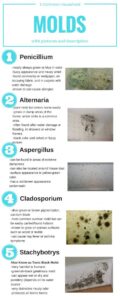Mold also sometimes referred to as mildew, is a fungal growth that develops on wet materials. Mold is a natural part of the environment and plays an important part in nature by breaking down dead organic matter such as fallen leaves and dead trees; indoors, mold growth should be avoided. Mold reproduce by means of tiny spores. The spores are like seeds, but invisible to the naked eye, that float through the air and deposit on surfaces. When the temperature, moisture, and available nutrient conditions are correct, the spores can form into new mold colonies where they are deposited There are many types of mold, but all require moisture and a food source for growth.
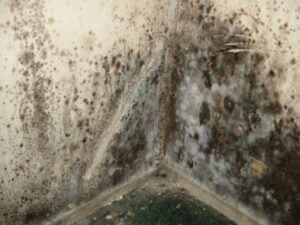
Mold growth in buildings generally occurs as fungi colonize porous building materials, such as wood. Many building products commonly incorporate paper, wood products, or solid wood members such as drywall, cabinets, and insulation. Interior mold colonization can lead to a variety of health problems as microscopic airborne reproductive spores, analogous to tree pollen, are inhaled by building occupants. High quantities of indoor airborne spores as compared to exterior conditions are strongly suggestive of indoor mold growth. Determination of airborne spore counts is accomplished by way of an air sample, in which a specialized pump with a known flow rate is operated for a known period of time. To account for background levels, air samples should be drawn from the affected area, a control area, and the exterior.
The air sampler pump draws in air and deposits microscopic airborne particles on a culture medium. The medium is cultured in a laboratory and the fungal genus and species are determined by visual microscopic observation. Laboratory results also quantify fungal growth by way of a spore count for comparison among samples. The pump operation time is recorded and when multiplied by pump flow rate results in a specific volume of air obtained. Although a small volume of air is actually analyzed, common laboratory reports extrapolate the spore count data to estimate spores that would be present in a cubic meter of air.
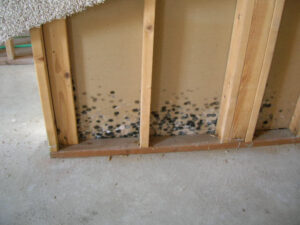
Various practices can be followed to mitigate mold issues in buildings, the most important of which is to reduce moisture levels that can facilitate mold growth. Properly functioning air conditioning (AC) units are essential to controlling levels of indoor airborne fungal spores. Air filtration reduces the number of spores available for germination, especially when a High Efficiency Particulate Air (HEPA) filter is used. A properly functioning AC unit also reduces the relative humidity in rooms. The United States Environmental Protection Agency (EPA) currently recommends that relative humidity be maintained below 60%, ideally between 30% to 50%, to inhibit mold growth. Considering that fungal growth requires cellulose, plant fiber, as a food source, using building materials that do not contain cellulose is an effective method of preventing fungal growth.
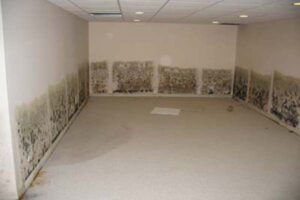
Eliminating the moisture source is the first step at fungal remediation. Removal of affected materials may also be necessary for remediation.
Hidden mold
Mold is detectable by smell and signs of water damage on walls or ceiling and can grow in places invisible to the human eye. It may be found behind wallpaper or paneling, on the inside of ceiling tiles, the back of drywall, or the underside of carpets or carpet padding. Piping in walls may also be a source of mold, since they may leak (causing moisture and condensation).
Spores need three things to grow into mold: nutrients – cellulose (the cell wall of green plants) is a common food for indoor spores; moisture – to begin the decaying process caused by mold; and time – mold growth begins from 24 hours to 10 days after the provision of growing conditions.
Mold colonies can grow inside buildings, and the chief hazard is the inhalation of mycotoxins. After a flood or major leak, mycotoxin levels are higher – even after a building has dried out.
Food sources for mold in buildings include cellulose-based materials such as wood, card board and the paper facing on drywall and organic matter such as soap, fabrics, and dust containing skin cells. If a house has mold, the moisture may originate in the basement or crawl space, a leaking roof or a leak in plumbing pipes. Insufficient ventilation may accelerate moisture buildup. Visible mold colonies may form where ventilation is poorest and on perimeter walls (because they are nearest the dew point).
If there are mold problems in a house only during certain times of the year, the house is probably too airtight or too drafty. Mold problems occur in airtight homes more frequently in the warmer months (when humidity is high inside the house, and moisture is trapped), and occur in drafty homes more frequently in the colder months (when warm air escapes from the living area and condenses). If a house is artificially humidified during the winter, this can create conditions favorable to mold. Moving air may prevent mold from growing, since it has the same desiccating effect as low humidity. Mold grow best in warm temperatures, 77 to 86 °F (25 to 30 °C), although growth may occur between 32 and 95 °F (0 and 35 °C).
Removing one of the three requirements for mold reduces (or eliminates) new mold growth: moisture; food for the mold spores (for example, dust or dander); and warmth since mold generally does not grow in cold environments.
HVAC systems can produce all three requirements for mold growth. The air conditioning system creates a difference in temperature, encouraging condensation. The high rate of dusty air movement through an HVAC system may furnish ample food for mold. Since the air-conditioning system is not always running, warm conditions are the final component for mold growth.
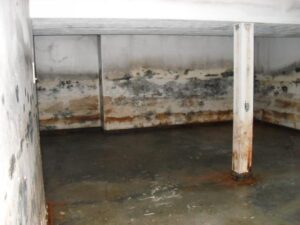
Health Hazards
Mycotoxins
Some mold produce mycotoxins, chemical components of their cells walls, that can pose serious health risks to humans and animals. “Toxic mold” refers to mold which produce mycotoxins, such as Stachybotrys chartarum. Exposure to high levels of mycotoxins can lead to neurological problems and death. Prolonged exposure (for example, daily exposure) can be particularly harmful. Mycotoxins can persist in the indoor environment even after death of the fungi. They can adhere to dust particles and can spread through the air attached to these dust particles or spores. There must be very specific temperature and humidity conditions in order for fungi to produce mycotoxins.
Symptoms
Symptoms of mold exposure may include nasal and sinus congestion; runny nose, eye irritation; itchy, red, watery eyes, respiratory problems, such as wheezing and difficulty breathing, chest tightness, cough, throat irritation, skin irritation (such as a rash), headache, and persistent sneezing. Immune-compromised people and people with chronic lung illnesses, such as obstructive lung disease, may get serious infections in their lungs when they are exposed to mold. These people should stay away from areas that are likely to have mold, such as compost piles, cut grass, and wooded areas.
Asthma
Infants may develop respiratory symptoms as a result of exposure to penicillium, a fungal genus. Signs of mold-related respiratory problems in an infant include a persistent cough or wheeze. Increased exposure increases the probability of developing respiratory symptoms during the first year of life. Studies have indicated a correlation between the probability of developing asthma and exposure to Penicillium.
Mold exposure has a variety of health effects, and sensitivity to mold varies. Exposure to mold may cause throat irritation, nasal stuffiness, eye irritation, cough and wheezing and skin irritation in some cases. Exposure to mold may heighten sensitivity, depending on the time and nature of exposure. People with chronic lung diseases are at higher risk for mold allergies, and will experience more severe reactions when exposed to mold. Damp indoor environments correlate with upper-respiratory-tract symptoms, such as coughing and wheezing in people with asthma.
Causes and growing conditions
Mold is found everywhere and can grow on almost any substance when moisture is present. They reproduce by spores, which are carried by air currents . When spores land on a moist surface suitable for life, they begin to grow. Mold is normally found indoors at levels which do not affect most healthy individuals.
Because common building material are capable of sustaining mold growth and mold spores are ubiquitous, mold growth in an indoor environment is typically related to water or moisture exposure and may be caused by incomplete drying of flooring materials (such as concrete).Flooding, leaky roofs, building-maintenance or indoor- plumbing problems can lead to interior mold growth. Water vapor commonly condenses on surfaces cooler than the moisture-laden air, enabling mold to flourish. This moisture vapor passes through walls and ceilings, typically condensing during the winter in climates with a long heating season. Floors over crawl spaces and basements, without vapor barriers or with dirt floors, are mold-prone. The “doormat test” detects moisture from concrete slabs without a sub-slab vapor barrier. Some materials, such as polished concrete, do not support mold growth.
Significant mold growth requires moisture and food sources and a substrate capable of sustaining growth. Common cellulose-based building materials, such as plywood, drywall, furring strips, finish carpentry, cabinetry, wood framing, composite wood flooring, carpets, and carpet padding provide food for mold. In carpet, organic load such as invisible dust and cellulose are food sources. After water damage to a building, mold grows in walls and then becomes dormant until subsequent high humidity; suitable conditions reactivate mold. Mycotoxin levels are higher in buildings which have had a water incident.
Remediation
Mold remediation
The first step in solving an indoor mold problem is to remove the moisture source: new mold will begin to grow on moist, porous surfaces within 24 to 48 hours. There are a number of ways to prevent mold growth.
The effective way to clean mold is to use detergent solutions which physically remove mold. Many commercially available detergents marketed for mold cleanup include an EPA-approved anti-fungal agent.
Significant mold growth may require professional mold remediation to remove the affected building materials and eradicate the source of excess moisture. In extreme cases of mold growth in buildings, it may be more cost-effective to condemn the building than to reduce mold to safe levels.
The goals of remediation are to remove (or clean) contaminated materials, preventing fungi (and fungi-contaminated dust) from entering an occupied (or non-contaminated) area while protecting workers performing the remediation.
